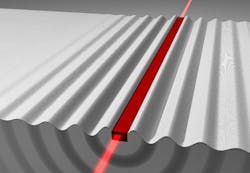| An artist's concept shows shows the emission of phonons from a nanometer-scale waveguide as photons flow through it. (Image: Yale University) |
Signal processing in integrated photonic circuits is essential to their application in chip-scale computing and sensing devices. Now, researchers from Yale University (New Haven, CT), Sandia National Laboratories (Albuquerque, NM), and the University of Texas at Austin have developed a radio-frequency (RF) processing device for more effective control of information in photonic circuits.1
The device combines coherent photons with phonons (sound quanta) to conduct sophisticated signal processing tasks by harnessing the properties of lower-velocity acoustic waves in the gigahertz range. The gigahertz phonons move at velocities much slower than light, allowing signal processing of light (such as storing, filtering, and delaying) to be done in very small areas.
Frequency-selective RF photonic filter
The researchers transmitted phonons between nanophotonic waveguides via a process called travelling-wave photon–phonon transduction, which led to the demonstration of a high-power, wavelength-insensitive, frequency-selective narrow-linewidth RF photonic filter.
"This is definitely something that's going to be built-upon in the years to come," says Peter Rakich, a Yale assistant professor of applied physics and principal investigator of the research. "It's a very different approach because of its flexibility. We've made something that is smaller as well as lighter, and can go on the same microchip with a processor."
Because the device is small enough to be placed on a silicon chip, it has the potential to be less expensive than other systems. It also has the potential to be adapted to a variety of complex signal-processing designs.
"Our work here is a combination of physics and engineering," says Heedeuk Shin, an associate research scientist in applied physics at Yale, and the study's first author. "We demonstrate a powerful new signal processing operation that isn't possible with photons alone."
Additional authors of the research are Jonathan Cox, Robert Jarecki, and Andrew Starbuck of Sandia National Laboratories, and Zheng Wang of the University of Texas Austin.
Source: http://news.yale.edu/2015/03/05/new-way-control-information-mixing-light-and-sound
REFERENCE:
1. Heedeuk Shin et al., Nature Communications (2015); doi:10.1038/ncomms7427
